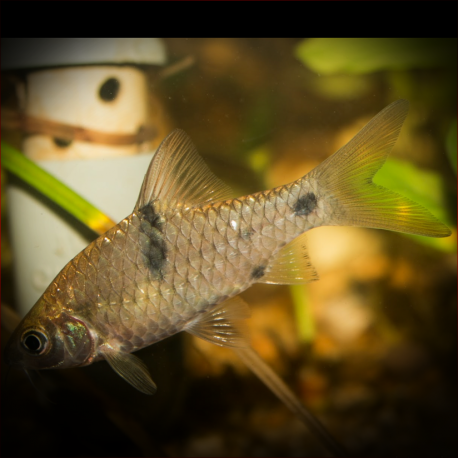More info
Datasheet
| Minimum Tank Size | 240 litres / 63.40 US gallons |
| Maximum Size | 11.0cm / 4.33inches |
| Temperature | 22°C / 71.60°F - 28°C / 82.40°F |
| Hardness | 1.01dgH / 18ppm - 10.03dgH / 179ppm |
| pH | 6.0-7.5 |
General Description
Barbodes banksi, formerly known as Puntius banksi, is a species of cyprinid fish recognized for its distinctive dark wedge-shaped markings on each flank. It belongs to the Cyprinidae family and can reach a maximum size of 11.0cm. This species is noted for being gregarious in nature and thrives in peaceful community aquarium setups.
Aquarium Setup
For optimal care, a tank of at least 240 litres is recommended. The aquarium should mimic a flowing stream or river environment with water-worn rocks, sand, fine gravel, and driftwood. Hardy aquatic plants like Microsorum or Anubias spp. can be added. Maintaining high dissolved oxygen levels and moderate water movement is essential. Regular water changes of 30-50% tank volume per week are advised.
Behaviour
Barbodes banksi is a peaceful and gregarious species that thrives in groups of 6 or more individuals. Maintaining them in decent numbers reduces skittish behavior and promotes a natural group dynamic. Aggressive tendencies are typically contained within the group as they establish hierarchical structures.
Feeding and Diet
As foraging omnivores, these fish consume various live and frozen foods such as bloodworms, Daphnia, and Artemia. A balanced diet of live, frozen, and high-quality dried foods ensures optimal health and vibrant colors. Regular feeding with a variety of food sources is recommended for their well-being.
Reproduction & Dimorphism
While specific details on the reproduction of Barbodes banksi are lacking, related species exhibit egg-scattering behavior without parental care. Male individuals typically develop more intense coloration and tubercles on the head during spawning. Females tend to grow slightly larger and have a heavier build.
Habitat and Distribution
Barbodes banksi is found in both lowland and elevated environments, inhabiting various biotopes ranging from fast-flowing hill streams to irrigation canals and lakes. Their distribution spans across Peninsular Malaysia, Singapore, and parts of Indonesia, including western Borneo and the Anambas and Natuna islands.
Remember, thorough research is crucial when creating a compatible fish community to avoid conflicts or issues within the aquarium environment.

